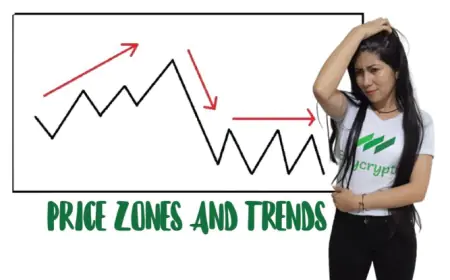Introduction to Contracts for Difference (CFDs): What Are and How do they Work?
Learn about Contracts for Difference (CFDs) in the financial market, their advantages and disadvantages, and common trading strategies. Discover how to choose a reliable CFD broker and how to effectively trade CFDs.

Welcome to our article about Contracts for Difference (CFDs), a popular form of trading in the financial markets. In this article, we will provide a comprehensive overview of what CFDs are, how they work, the advantages and disadvantages of trading with CFDs, as well as common strategies used in CFD trading. Whether you are a seasoned trader or just getting started, this article will provide you with valuable insights into the world of CFD trading. So, let's dive in!
What are CFDs and How do They Work?
CFDs, or Contracts for Difference, are financial derivatives that allow investors to speculate on the rise or fall of the prices of underlying assets without actually owning the assets. Instead of buying or selling assets, traders buy or sell contracts that represent a certain value of the underlying asset.
The concept of CFDs was introduced in the early 1990s in London, UK. CFDs quickly gained popularity among institutional investors due to their flexibility and ability to enable investors to profit from both rising and falling markets. Today, CFDs are widely traded by individual investors as well.
CFDs are typically traded on margin, which means that traders can open larger positions with smaller capital compared to traditional investments. The margin requirement varies depending on the broker and the underlying asset being traded. CFDs are usually traded with a leverage, which means that traders can amplify their profits, but also their losses.
CFDs are offered on a wide range of underlying assets, including but not limited to stocks, commodities, currencies, and indices. The prices of CFDs are derived from the prices of the underlying assets, which means that traders can benefit from the price movements of the underlying assets without owning them.
In the next part, we will discuss how CFDs are traded.
How are CFDs traded?
CFDs are typically traded through a broker, who acts as the intermediary between the trader and the market. The broker will quote two prices for the underlying asset, a bid price and an ask price. The bid price is the price at which the broker is willing to buy the asset, while the ask price is the price at which the broker is willing to sell the asset.
The difference between the bid price and the ask price is known as the spread. This spread is the primary way in which the broker earns their commission. It's important to note that the spread can vary widely depending on the asset being traded and the market conditions.
To open a CFD trade, the trader will need to deposit a certain amount of money, known as the margin. The margin required can vary depending on the asset being traded, the broker, and the amount of leverage being used. Leverage allows the trader to control a larger position with a smaller amount of capital, but it also increases the potential risk of the trade.
Once the trade is opened, the trader can monitor their position in real-time and decide when to close the trade. If the trade is profitable, the trader will receive the difference between the opening price and the closing price of the trade. If the trade is unprofitable, the trader will incur a loss equal to the difference between the opening price and the closing price.
It's important to note that CFDs are typically traded on margin, which means that losses can exceed the initial margin deposit. As a result, traders should always have a clear understanding of the risks involved and use risk management strategies such as stop-loss orders to limit their potential losses.
In the next section, we'll discuss some of the advantages and disadvantages of trading CFDs
Advantages and Disadvantages of Trading CFDs
Like any other financial instrument, CFDs have their advantages and disadvantages that traders must be aware of before investing. Let's take a look at some of them.
Advantages of Trading CFDs
- Leverage: One of the biggest advantages of trading CFDs is the ability to trade with leverage. This allows traders to open larger positions with a smaller amount of capital, thus increasing their potential profits.
- Access to a wide range of markets: CFDs allow traders to access a wide range of markets, including stocks, indices, commodities, and currencies, all from a single platform.
- Flexibility: CFDs offer flexibility in terms of position sizing, allowing traders to open positions of any size they wish.
- Short selling: With CFDs, traders can also profit from falling markets by selling short. This means that they can profit from both rising and falling markets.
Disadvantages of Trading CFDs
- High risk: Trading CFDs involves a high level of risk due to the use of leverage, which can amplify both profits and losses.
- Hidden fees and charges: Some brokers may charge hidden fees and commissions, which can eat into traders' profits.
- No ownership of underlying asset: When trading CFDs, traders do not own the underlying asset but are instead speculating on its price movements. This means that they do not have any voting rights or other ownership privileges.
- Overtrading: The ease of trading CFDs can lead to overtrading, which can result in significant losses.
Common Strategies Used in CFD Trading
In order to be a successful CFD trader, it is important to have a solid trading strategy. Below are some of the most common strategies used in CFD trading:
-
Trend following: This strategy involves following the trend of the market and making trades based on that trend. Traders who use this strategy will typically buy when the market is trending upwards and sell when the market is trending downwards.
-
Contrarian: This strategy involves going against the trend of the market. Traders who use this strategy will typically buy when the market is trending downwards and sell when the market is trending upwards.
-
Range trading: This strategy involves identifying a range of prices that a particular asset is trading within and making trades based on that range. Traders who use this strategy will typically buy when the price is at the lower end of the range and sell when the price is at the upper end of the range.
-
News trading: This strategy involves making trades based on news and events that can affect the market. Traders who use this strategy will typically buy or sell based on the news and events that are happening in the market.
-
Scalping: This strategy involves making quick trades to take advantage of small price movements in the market. Traders who use this strategy will typically make trades that last only a few minutes or seconds.
It is important to note that each strategy has its own risks and rewards, and it is up to the individual trader to decide which strategy is best for them. It is also important to constantly adapt and refine your strategy as the market changes.
Conclusion:
In conclusion, trading CFDs can be a highly lucrative venture for those who are well-informed and prepared to manage the associated risks. As with any investment, it's important to do your due diligence and carefully choose a reliable broker before diving in. It's also crucial to develop a solid understanding of the mechanics of CFD trading and the various strategies employed by successful traders. By following these guidelines and maintaining discipline and caution, CFD trading can offer significant potential rewards in the exciting
What's Your Reaction?
 Like
0
Like
0
 Dislike
0
Dislike
0
 Love
0
Love
0
 Funny
0
Funny
0
 Angry
0
Angry
0
 Sad
0
Sad
0
 Wow
0
Wow
0





































